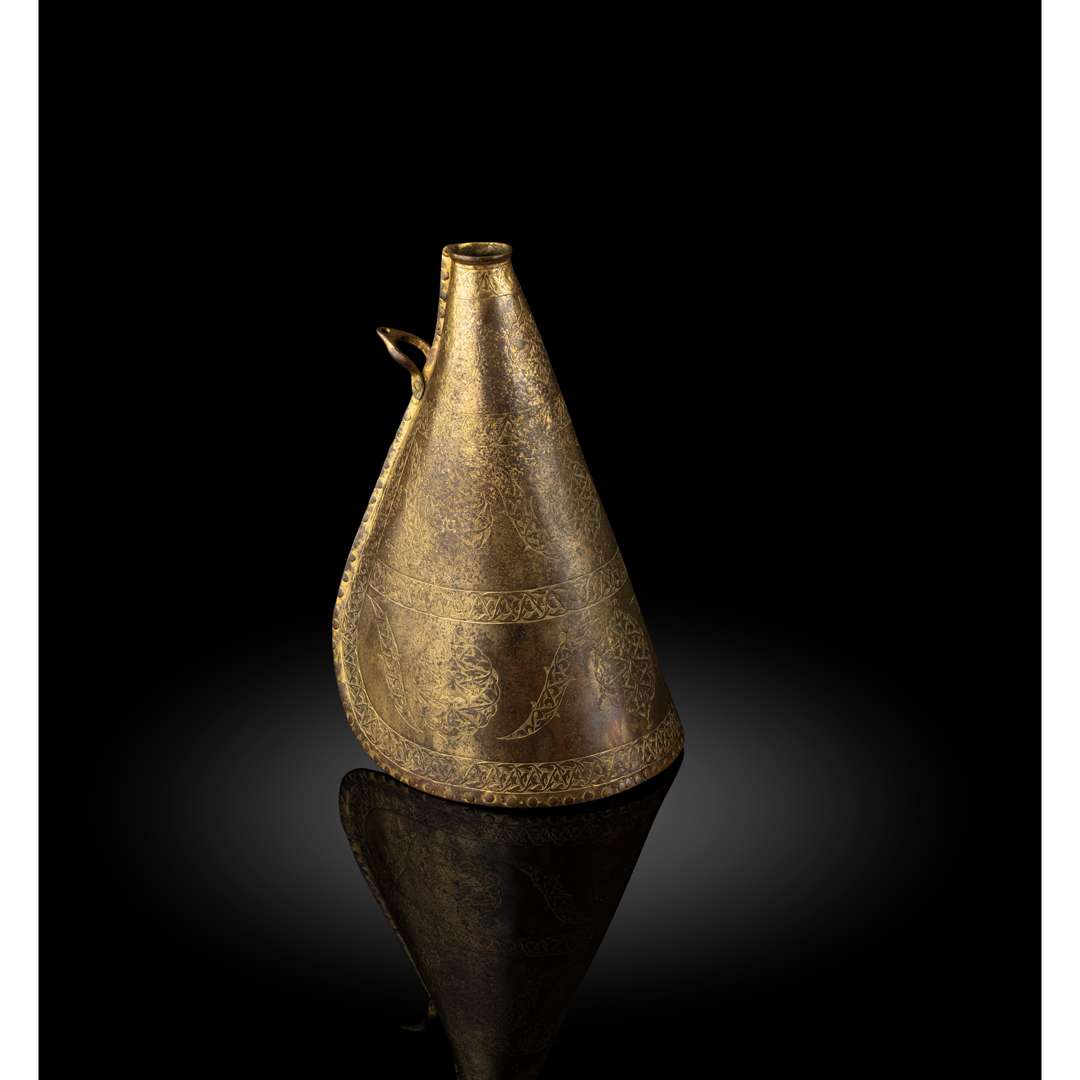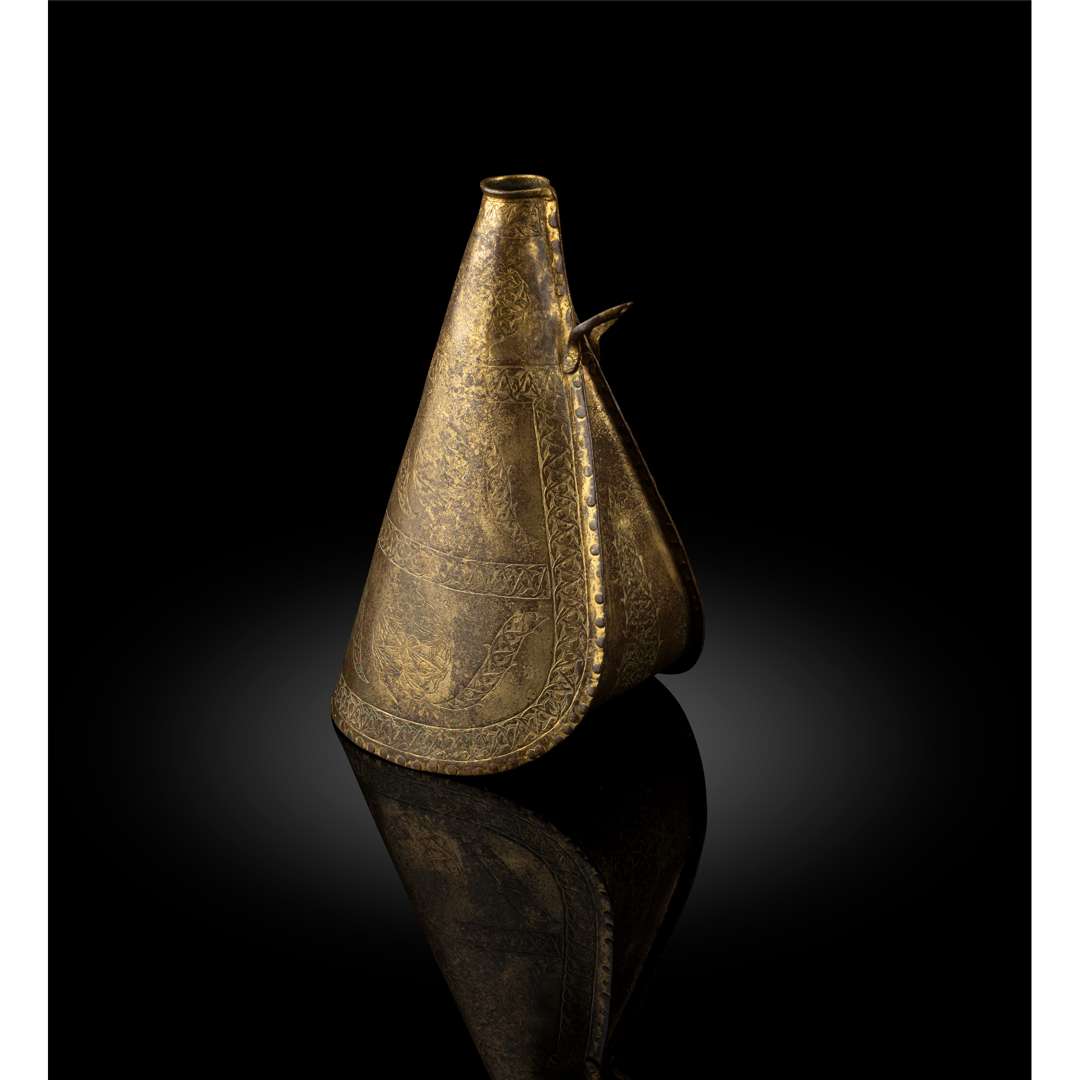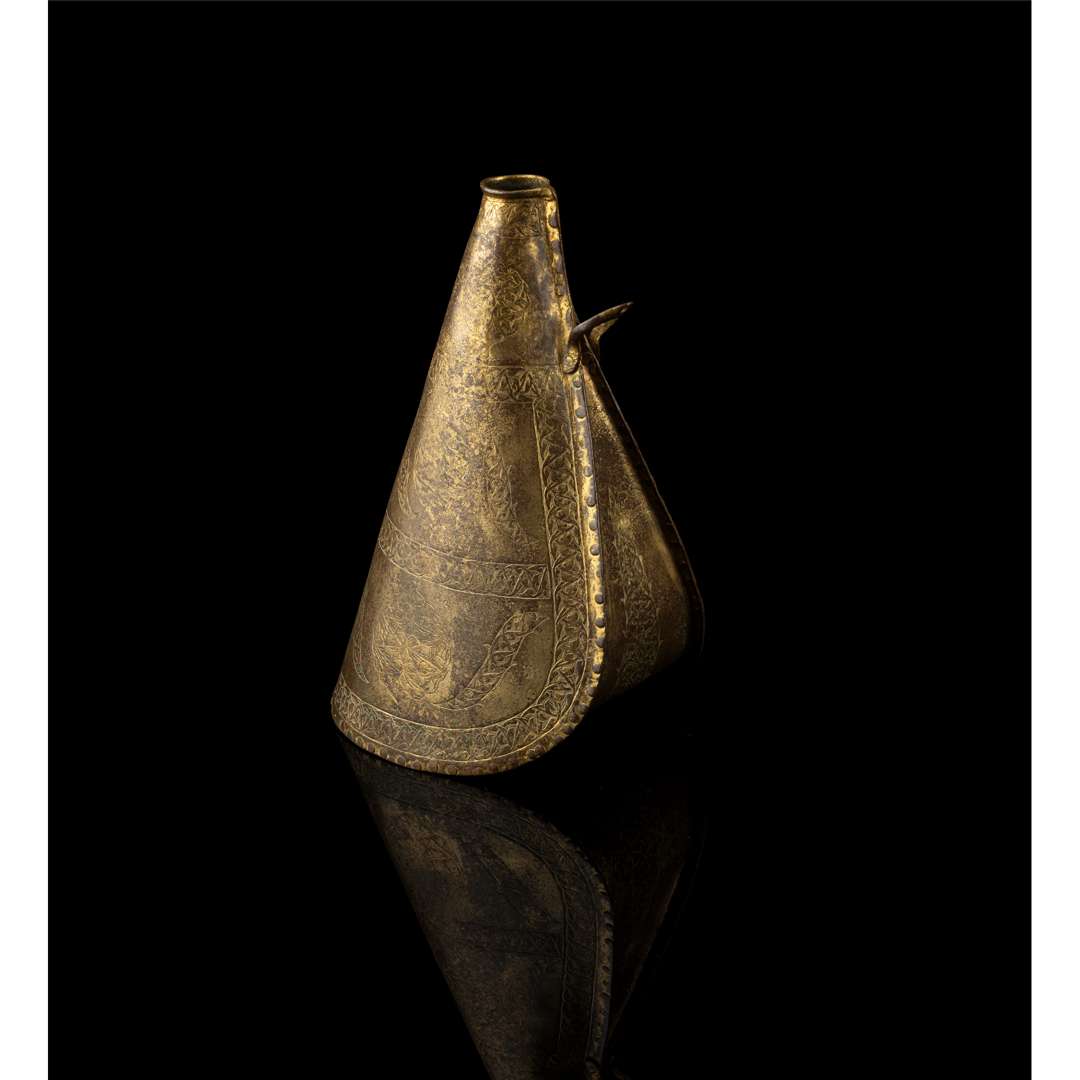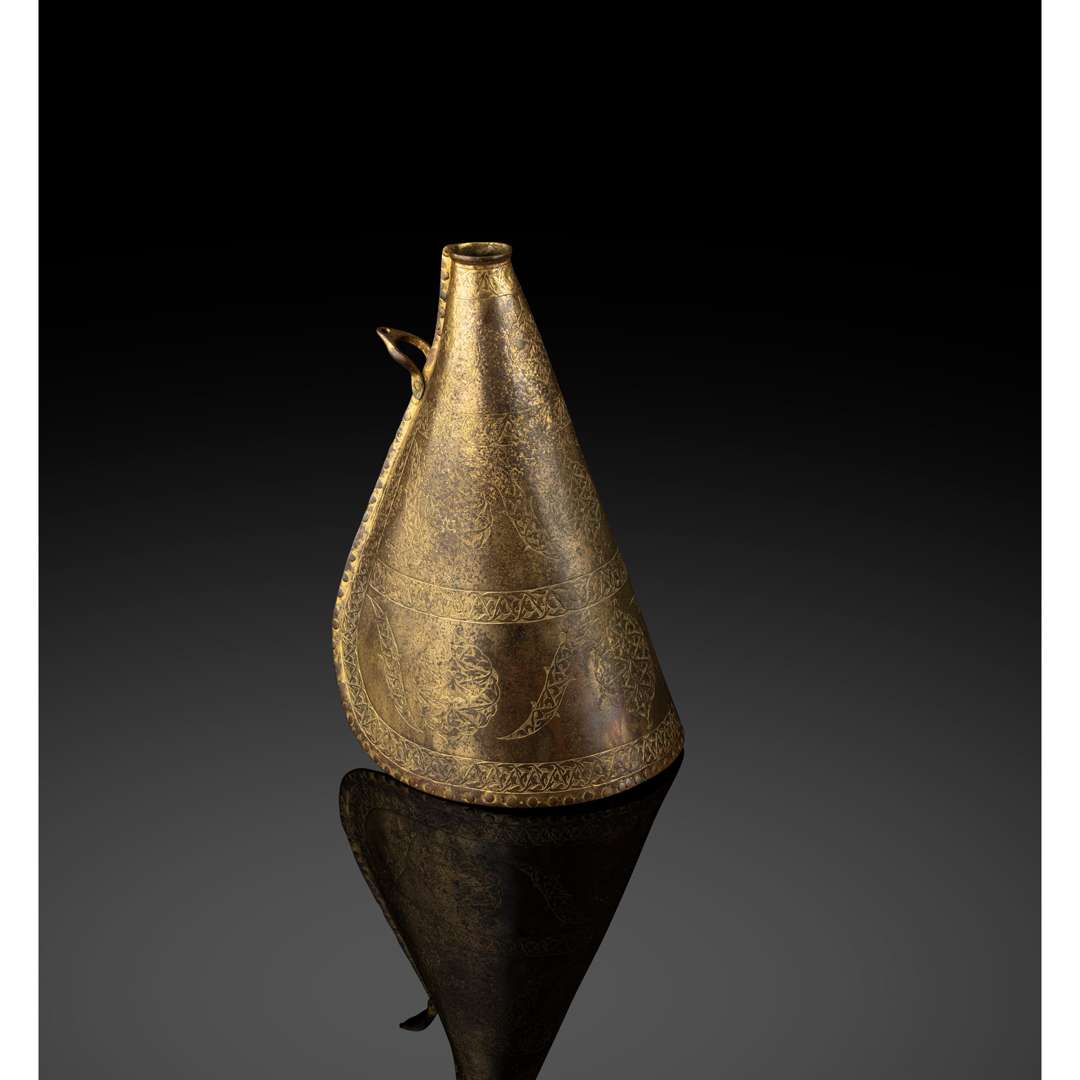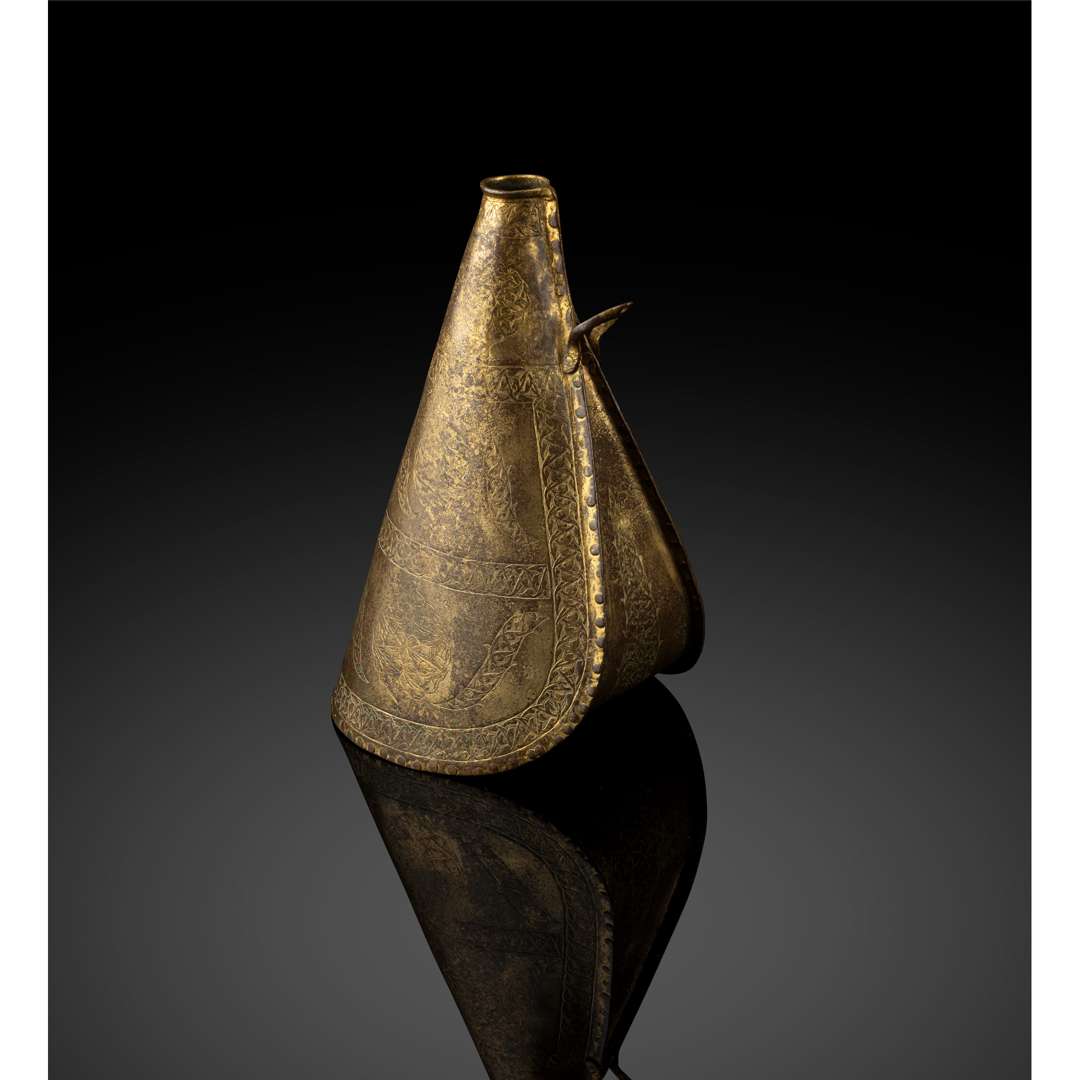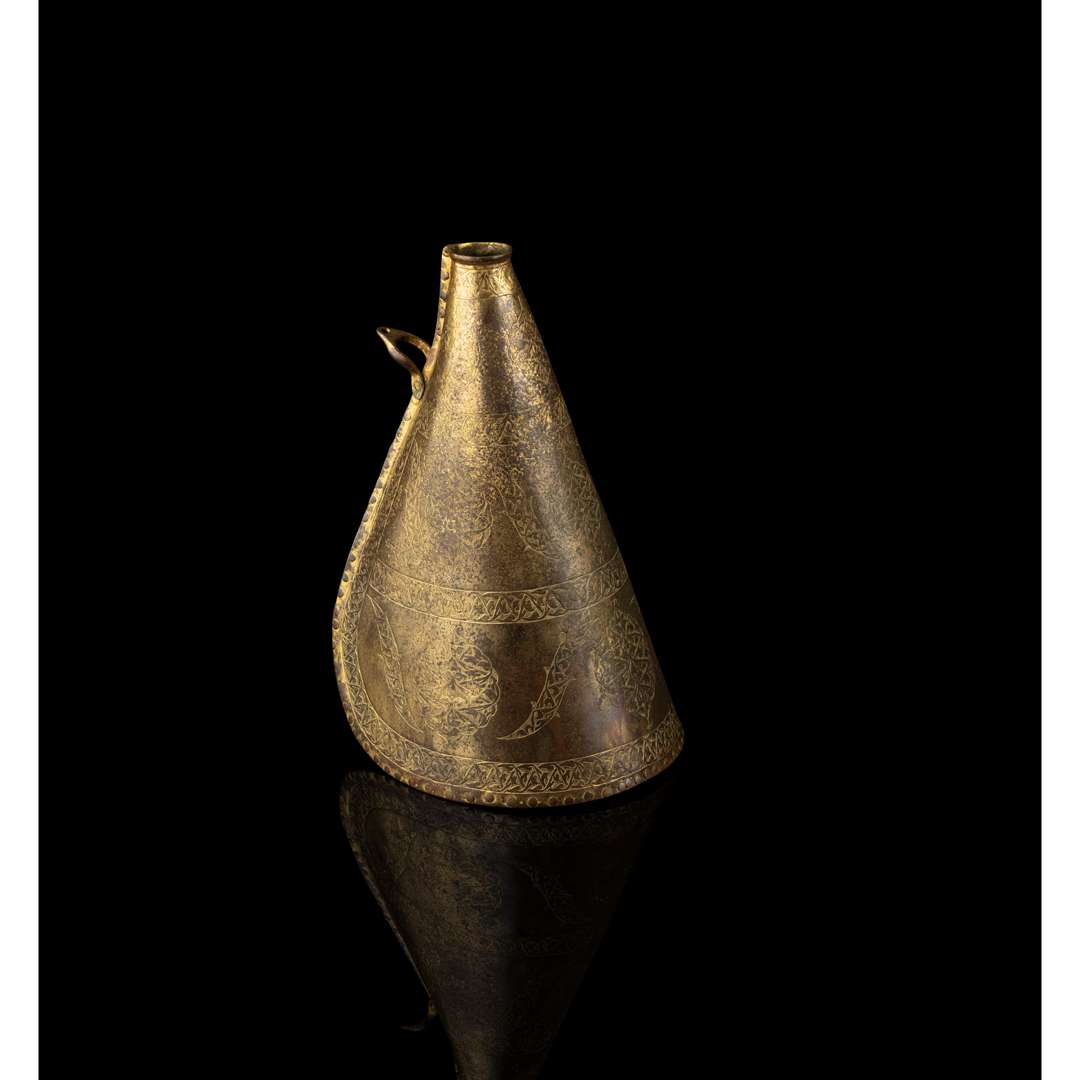42
A RARE OTTOMAN GILT-COPPER (TOMBAK) PILGRIM FLASK (MATARA)
TURKEY, 17th CENTURY
of slender pyramid form, made of two sheets of beaten gilded copper, one sheet wrapped like a robe and soldered at the collar with a circular narrow spout terminal, with a seam of rivets and a loop handle, the other sheet of metal soldered to the seams of the main sheet, the front engraved decoration divided into three wide bands containing large cusped medallions and palmettes filled with entwined split palmettes, continuous entwined split palmettes within the dividing bands
27cm (10 ¾in) high; 15.5cm (6 ¼in) max. width
Note:This is a rare and very fine example of an Ottoman matara or flask, a form drawn from the very humblest of materials but one which is associated with the power and piety of the Ottoman Empire at its peak. The present piece is formed from two sheets of metal, the larger folded around and joined at the back of the flask with a series of rivets. The material used is gilt-copper, referred to in Turkish as tombak; this term may be derived from the Malay tambaga (‘copper’), this metal being used in the alloy which forms the body. This surface would then be mercury-gilded, creating a luxurious effect often visually indistinguishable from pure gold (İ. Gündağ Kayaoğlu, Tombak, Istanbul: 1992, p. 2). The dating of the present piece is suggested through comparison with the palmettes on a parcel gilt silver incense burner in the Türk ve İslam Eserleri Müzesi, which carries the date 1033 AH/1624-5 CE (Yanni Petsopoulos (ed.), Tulips, Arabesques & Turbans: Decorative Arts from the Ottoman Empire, New York: 1982, p. 48 and fig. 53).The rivets on this piece point towards the prototype of this form, referencing the heavy stitching used on contemporary leather mataras, including one of near-identical form now in the Sadberk Hanım Museum [Hülya Bilgi, Reunited after Centuries: Works of Art Returned to Turkey by the Sadberk Hanım Museum, Istanbul: 2005, no. 48]. Another flask in the Metropolitan Museum of Art also displays its debt to leather through both its form and decoration. Metal examples such as these would have been used as emblems of rank among the elite (Stuart Carey Welch, The Islamic World Vol. 11, New York: 1987, p. 125]. In the Tarih-i Sultan Süleyman, completed in 1579-80, the matara is shown as part of the Sultan’s personal regalia alongside his sword [Esin Atıl, The Age of Sultan Süleyman the Magnificent, Washington, DC: 1987, p. 94). More than mere receptacles for water, mataras were an essential part of Ottoman imperial finery, and alongside the appliqué leather example sent as a diplomatic gift from Murad III to the Habsburg Rudolph II, now in the Kunsthistorisches Museum, Vienna (C.28), there are examples in even more rarefied materials including gem-encrusted solid gold and rock crystal (Esin Atıl, The Age of Sultan Süleyman the Magnificent, Washington, DC: 1987, pp. 123-5, 128-30). A later leather matara in the Khalili Collection (MXD 366), of the same shape as the present example, appears to have been used to hold water from the holy well of Zamzam in Mecca. A matara such as the present example can be seen as the nexus of faith and rule under the Ottomans, stretching between the imperial capital in Istanbul as far as the holy city of Mecca in the distant Hijaz.
TURKEY, 17th CENTURY
of slender pyramid form, made of two sheets of beaten gilded copper, one sheet wrapped like a robe and soldered at the collar with a circular narrow spout terminal, with a seam of rivets and a loop handle, the other sheet of metal soldered to the seams of the main sheet, the front engraved decoration divided into three wide bands containing large cusped medallions and palmettes filled with entwined split palmettes, continuous entwined split palmettes within the dividing bands
27cm (10 ¾in) high; 15.5cm (6 ¼in) max. width
Note:This is a rare and very fine example of an Ottoman matara or flask, a form drawn from the very humblest of materials but one which is associated with the power and piety of the Ottoman Empire at its peak. The present piece is formed from two sheets of metal, the larger folded around and joined at the back of the flask with a series of rivets. The material used is gilt-copper, referred to in Turkish as tombak; this term may be derived from the Malay tambaga (‘copper’), this metal being used in the alloy which forms the body. This surface would then be mercury-gilded, creating a luxurious effect often visually indistinguishable from pure gold (İ. Gündağ Kayaoğlu, Tombak, Istanbul: 1992, p. 2). The dating of the present piece is suggested through comparison with the palmettes on a parcel gilt silver incense burner in the Türk ve İslam Eserleri Müzesi, which carries the date 1033 AH/1624-5 CE (Yanni Petsopoulos (ed.), Tulips, Arabesques & Turbans: Decorative Arts from the Ottoman Empire, New York: 1982, p. 48 and fig. 53).The rivets on this piece point towards the prototype of this form, referencing the heavy stitching used on contemporary leather mataras, including one of near-identical form now in the Sadberk Hanım Museum [Hülya Bilgi, Reunited after Centuries: Works of Art Returned to Turkey by the Sadberk Hanım Museum, Istanbul: 2005, no. 48]. Another flask in the Metropolitan Museum of Art also displays its debt to leather through both its form and decoration. Metal examples such as these would have been used as emblems of rank among the elite (Stuart Carey Welch, The Islamic World Vol. 11, New York: 1987, p. 125]. In the Tarih-i Sultan Süleyman, completed in 1579-80, the matara is shown as part of the Sultan’s personal regalia alongside his sword [Esin Atıl, The Age of Sultan Süleyman the Magnificent, Washington, DC: 1987, p. 94). More than mere receptacles for water, mataras were an essential part of Ottoman imperial finery, and alongside the appliqué leather example sent as a diplomatic gift from Murad III to the Habsburg Rudolph II, now in the Kunsthistorisches Museum, Vienna (C.28), there are examples in even more rarefied materials including gem-encrusted solid gold and rock crystal (Esin Atıl, The Age of Sultan Süleyman the Magnificent, Washington, DC: 1987, pp. 123-5, 128-30). A later leather matara in the Khalili Collection (MXD 366), of the same shape as the present example, appears to have been used to hold water from the holy well of Zamzam in Mecca. A matara such as the present example can be seen as the nexus of faith and rule under the Ottomans, stretching between the imperial capital in Istanbul as far as the holy city of Mecca in the distant Hijaz.
Islamic & Indian Art
Sale Date(s)
Venue Address
COLLECTIONS & STORAGE OF PURCHASED LOTS
FOR INTERNATIONAL BUYERS & UK (OUTSIDE SCOTLAND) BUYERS
STORAGE: Items will be stored at 22 Connaught Street, until Wednesday 26th June at 5pm.
Thereafter we will store items at Stephen Morris Shipping Ltd., 15 Ockham Drive, Greenford Park, Greenford, UB6 0FD. Telephone +44(0)20 8832 2222. Items will be available to collect from 9am on Monday 1st July
Please ensure payment has been made prior to collection. This can be done online, bank transfer or in person at our London office - details will be shown on your invoice also. Please note we are unable to accept cash or payments over the phone.
COST: Please note from Thursday 27th June you will be charged by our storage partners.
Insurance 0.25% (all items)
Smalls (paintings and objects) - £2.50 admin fee then £1.00 per day.
Furniture pieces - £5.50 admin fee then £2.50 per day.
FOR SCOTTISH BUYERS
STORAGE: Items will be stored at 22 Connaught Street, until Wednesday 26th June at 5pm.
Thereafter items will be transported to our Edinburgh saleroom and will be available to collect by appointment.
All collections will be by appointment only (this applies to both carriers and personal collections).
CALL 0131 557 8844
EMAIL info@lyonandturnbull.com
-------
UK & International - Smaller items and paintings
Mailboxes Etc
8 Shepherd Market
Mayfair
London, W1J 7JY
Tel: 0207 491 0022
info@mbemayfair.co.uk
Mailboxes Etc
61 Praed Street
London, W2 1NS
Tel: 0207 706 3666
info@mbepaddington.co.uk
Pack & Send Edinburgh East
53 Elm Row
Leith Walk
Edinburgh, EH7 4AH
Tel: 0131 201 2244
edinburgheast@packsend.co.uk
www.packsend.co.uk/edinburgheast
UK & International - Larger items
Aardvark Art Services Ltd
Tel: 01253 794 673
info@aardvarkartservices.com
Constantine Moving Services (Specialists in UK & International Shipping)
Constantine House
North Caldeen Road
Coatbridge, ML5 4EF
Tel: 01236 430 681
allanak@constantinemoving.com
A Van Man Transport
Unit 5, Benridge Park
Holyrood Close, Creekmoor
Poole, Dorset, BH17 7BD
Tel: 01202 600 012
office@avmt.co.uk
Gallery Support Group
Unit 4, 89 Manor Farm Road
Wembley
London, HA0 1BA
Tel: 020 305 307 53
info@gallerysupportgroup.com
Important Information
BUYER'S PREMIUM
The buyer shall pay the hammer price together with a premium, at the following rate, thereon.
26% up to £20,000
25% from £20,001 to £500,000
20% thereafter
VAT will be charged on the premium at the rate imposed by law (see our Conditions of Sale at the back of this catalogue).
ADDITIONAL VAT
† VAT at the standard rate payable on the hammer price
‡ Reduced rate of 5% import VAT payable on the hammer price
[Ω] Standard rate of import VAT on the hammer price
Lots affixed with ‡ or [Ω] symbols may be subject to further regulations upon export /import, please see Conditions of Sale for Buyers Section D.2.
No VAT is payable on the hammer price or premium for books bought at auction
REGISTRATION
All potential buyers must register prior to placing a bid. Paddle registration must be completed in advance of the sale day. Please note that all first-time, and those returning after an extended period, bidders at Lyon & Turnbull will be asked to supply the following documents in order to facilitate registration:
1 – Government issued photo ID (Passport/Driving licence)
2 – Proof of address (utility bill/bank statement).
By registering for the sale, the buyer acknowledges that he or she has read, understood and accepted our Conditions of Sale.
ARTIST’S RESALE ROYALTY (DROIT DE SUITE)
This symbol § indicates works which may be subject to the Droit de Suite or Artist’s Resale Right, which took effect in the United Kingdom on 14th February 2006. We are required to collect a royalty payment for all qualifying works of art. Under new legislation which came into effect on 1st January 2012 this applies to living artists and artists who have died in the last 70 years. This royalty will be charged to the Buyer on the Hammer Price and in addition to the Buyer’s Premium. It will not apply to works where the Hammer Price is less than €1,000 (euros). The charge for works of art sold at and above €1,000 (euros) and below €50,000 (euros) is 4%. For items selling above €50,000 (euros), charges are calculated on a sliding scale. All royalty charges are paid to the Design and Artists Copyright Society (‘DACS’) and no handling costs or additional fees are retained by the Auctioneer. Resale royalties are not subject to VAT. Please note that the royalty payment is calculated on the rate of exchange at the European Central Bank on the date of the sale. More information on Droit de Suite is available at www.dacs.org.uk.
REMOVAL OF PURCHASES
Responsibility for packing, shipping and insurance shall be exclusively that of the purchaser. See Collections & Storage section for more info specific to this particular auction.
CATALOGUE DESCRIPTIONS
All item descriptions, dimensions and estimates are provided for guidance only. It is the buyer’s responsibility to inspect all lots prior to bidding to ensure that the condition is to their satisfaction. Our specialists will be happy to prepare condition reports and additional images. These are for guidance only and all lots are sold ‘as found’, as per our Conditions of Sale.
IMPORT/EXPORT
Prospective buyers are advised that several countries prohibit the importation of property containing materials from endangered species, including but not limited to; rosewood, rhino horn, ivory, coral and tortoiseshell. Accordingly, prospective buyers should familiarise themselves with all relevant customs regulations prior to bidding if they intend to import lots to another country. It is the buyer’s sole responsibility to obtain any relevant export or import licence. The denial of any licence or any delay in obtaining licences shall neither justify the recession of any sale nor any delay in making full payment for the lot.
ENDANGERED SPECIES
Please be aware that lots marked with the symbol Y contain material which may be subject to CITES regulations when exporting outside Great Britain. For more information visit https://www.defra.gov.uk/ahvla-en/imports-exports/cites
Terms & Conditions
UK - Conditions Of Sale For Buyers
These Conditions of Sale and the Saleroom Notices as well as specific Catalogue terms, set out the terms on which we offer the Lots listed in this Catalogue for sale. By registering to bid and/or by bidding at auction You agree to these terms, we recommend that You read them carefully before doing so. You will find a list of definitions and a glossary at the end providing explanations for the meanings of the words and expressions used.
Special terms may be used in Catalogue descriptions of particular classes of items (Books, Jewellery, Paintings, Guns, Firearms, etc.) in which case the descriptions must be interpreted in accordance with any glossary appearing in the Catalogue. These notices and terms will also form part of our terms and conditions of sales.
In these Conditions the words “Us”, “Our”, “We” etc. refers to Lyon & Turnbull Ltd, the singular includes the plural and vice versa as appropriate. “You”, “Your” means the Buyer.
Lyon & Turnbull Ltd. acts as agent for the Seller. On occasion where Lyon & Turnbull Ltd. own a lot in part or full the property will be identified in the catalogue with the symbol (


















